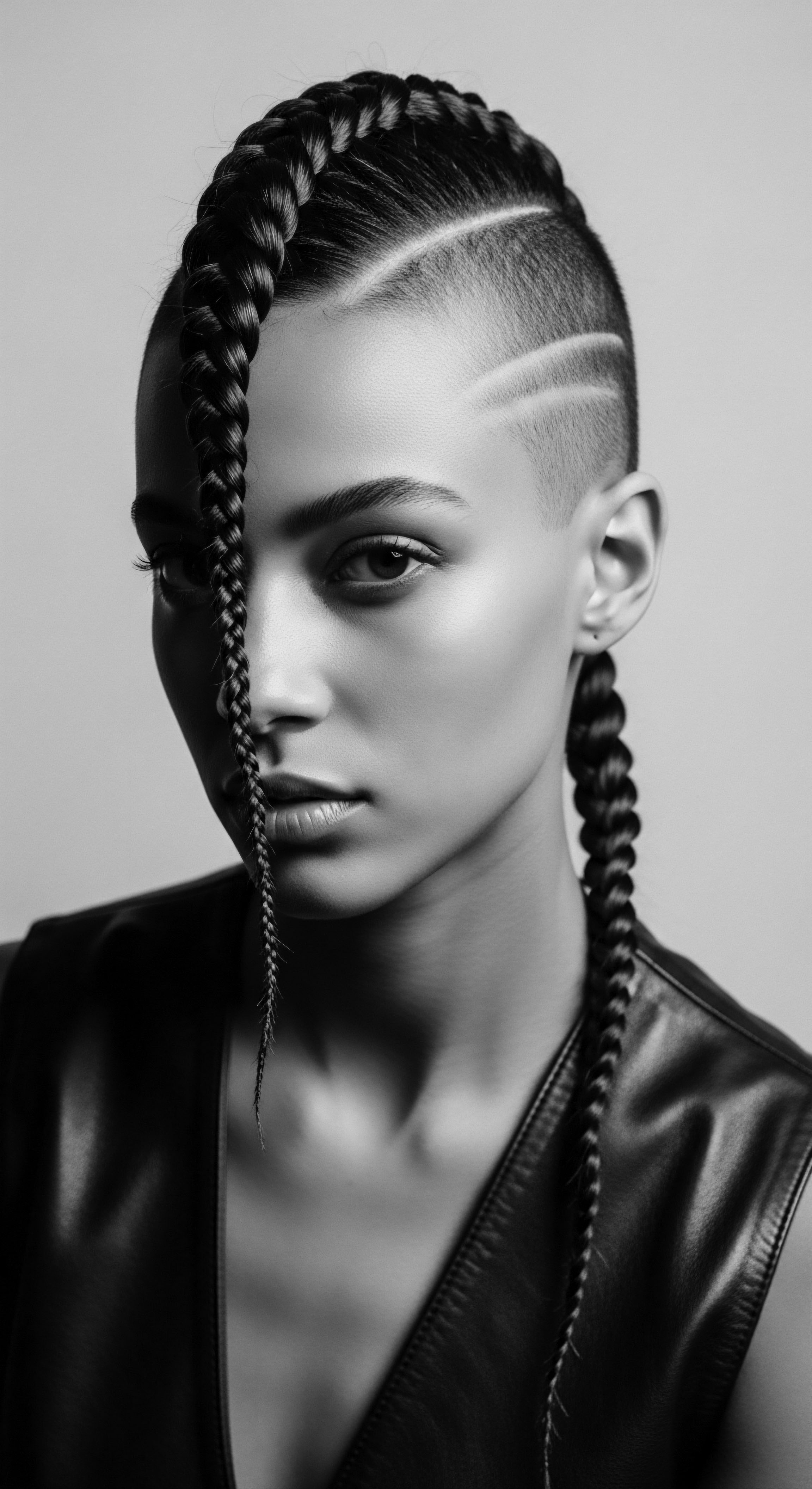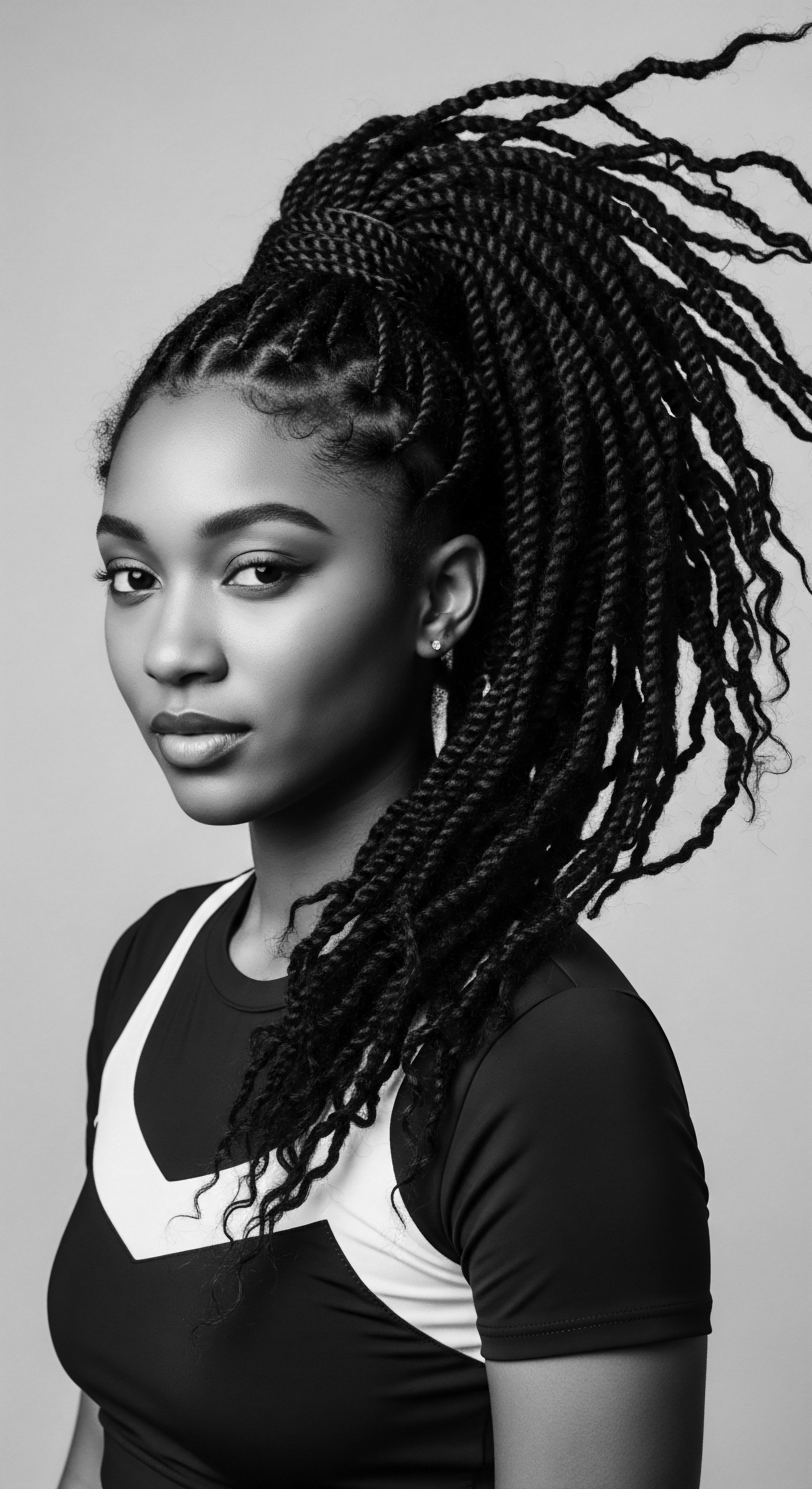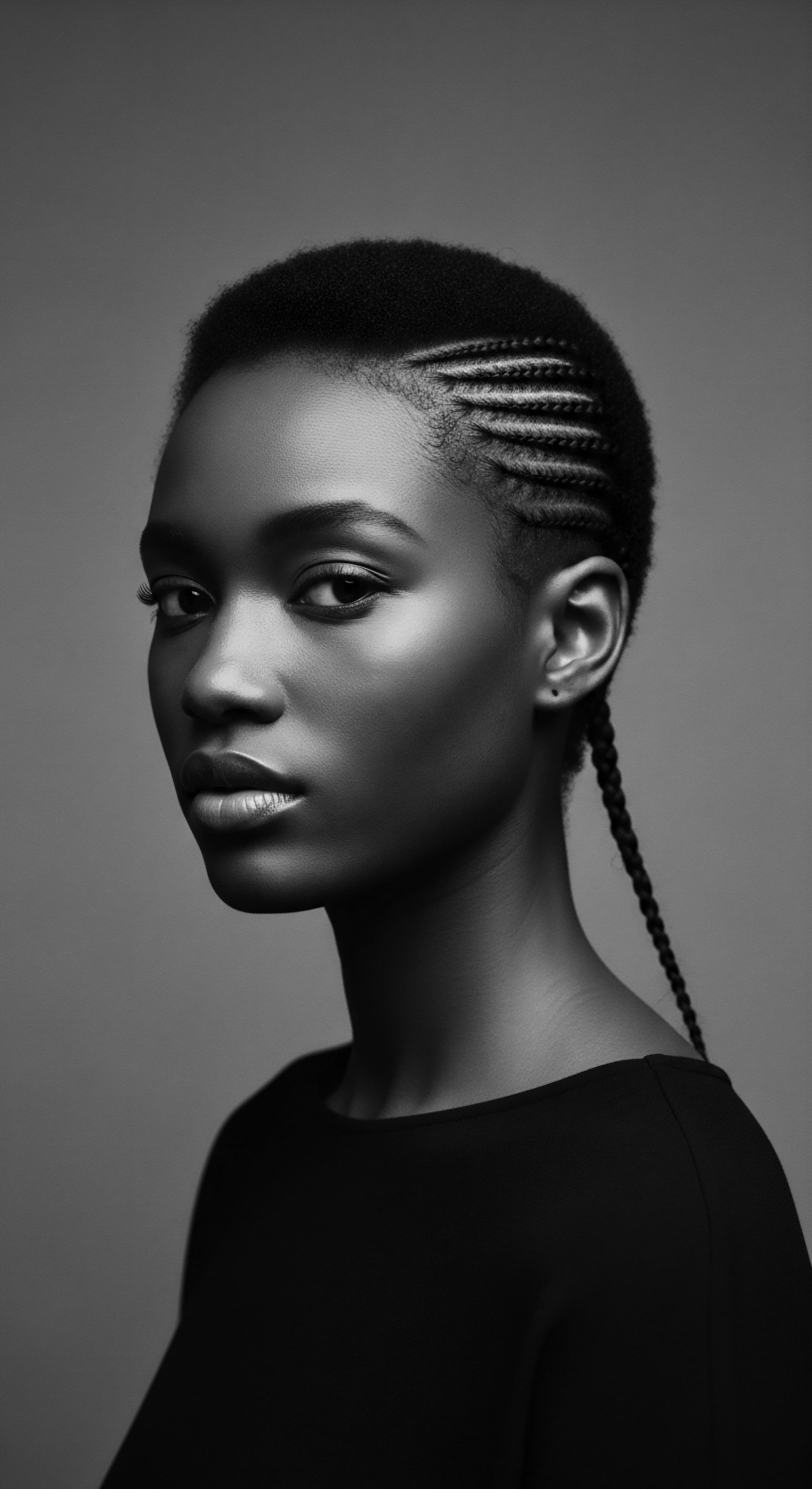
Roots
The very notion of what oils were historically central to Caribbean textured hair traditions carries with it echoes of an ancient continuum, a profound connection to ancestry that stretches across continents and centuries. For those of us whose lineage is intertwined with the vibrant, yet often challenging, history of the Caribbean, understanding these oils transcends simple product knowledge. It is a dialogue with the past, a recognition of ingenuity born from survival, and a celebration of enduring beauty practices. This exploration begins not just with botanicals, but with the very essence of how textured hair, in its myriad coils and curls, became a canvas for cultural expression, resilience, and the deeply personal act of care, particularly through the lens of heritage.
Caribbean hair heritage is a rich mosaic, shaped by the confluence of Indigenous peoples, forcibly displaced Africans, and later, European and Asian influences. Each group, in their struggle and adaptation, contributed to a unique approach to hair care, often relying on the natural abundance of the islands. The specific oils that rose to prominence were not chosen by chance; their properties spoke to the fundamental needs of textured strands in a humid, tropical climate, while also carrying the weight of tradition and ancestral wisdom. These traditional applications helped hair thrive and also served as silent acts of cultural preservation.

The Sacred Strand Anatomical Heritage
To truly appreciate the role of historical oils, one must first grasp the distinct anatomical qualities of textured hair. Unlike straighter hair types, coily and curly strands possess a unique elliptical or flattened cross-section, which influences how natural oils travel down the hair shaft. The bends and turns, the very architecture of a textured strand, mean that naturally produced sebum struggles to descend from the scalp to the ends, leaving the lengths drier and more prone to breakage.
This inherent characteristic made external lubrication a biological necessity, one that ancestral communities instinctively understood. The oils chosen were not merely cosmetic additions; they were functional allies, working in harmony with the hair’s natural inclinations.
Understanding the unique elliptical structure of textured hair illuminates the biological necessity for external oils, a wisdom deeply woven into ancestral Caribbean care practices.
From a scientific perspective, the ricinoleic acid in castor oil, for instance, exhibits properties that improve scalp circulation, which in turn nurtures hair growth. Pimento oil, too, known for its stimulating qualities, works in concert with these biological needs, promoting a robust environment for hair. These natural ingredients, passed down through generations, effectively addressed the biological reality of textured hair, long before modern science could articulate the precise mechanisms.

Mapping the Hair Lexicon Ancestral Roots
The language used to describe textured hair and its care in the Caribbean holds ancestral echoes. Terms like “good hair” or “bad hair,” unfortunately prevalent due to the colonial legacy of colorism, highlight the societal pressures endured by Black and mixed-race communities. Yet, alongside these painful classifications, there existed a vernacular of practical care, often tied to the specific plants and their extracts. The very act of naming these oils and practices carried a cultural weight, a shared understanding of their power.
- Castor Oil ❉ Known widely across the Caribbean, particularly its dark, roasted variant.
- Coconut Oil ❉ A staple throughout the tropical islands, prized for its ready availability and moisturizing properties.
- Pimento Oil ❉ Indigenous to the Caribbean, especially Jamaica, and valued for its stimulating qualities.
- Moringa Oil ❉ Arrived in the Caribbean through historical migrations, celebrated for its nutrient density.
- Soursop Oil ❉ Derived from a fruit native to the Americas and Caribbean, recognized for its conditioning benefits.
Each oil carries its own story, its own segment of Caribbean heritage. The methods of extraction, often laborious and community-driven, speak to a time when resources were harnessed with intention and reverence. These ancestral practices were not merely about hygiene; they were about identity, connection, and survival.

Ritual
The rhythms of Caribbean life, often dictated by the sun and sea, shaped hair care into a ritualistic dance. Beyond mere application, the use of specific oils in textured hair traditions was an act imbued with familial warmth, communal bonding, and a deep, intuitive understanding of nature’s bounty. These rituals, passed down through generations, were practical responses to environmental challenges and cultural expressions of self-adornment, forming a tangible link to heritage. The selection of oils for protective styles, daily moisture, and even ceremonial adornment speaks volumes about the holistic approach to beauty that characterized these practices.

What Did Hair Oiling Mean Beyond Simple Conditioning?
In many Caribbean households, the act of hair oiling transcended the mundane. It became a moment of tender connection between mothers and daughters, grandmothers and granddaughters. Fingers, slick with oil, would work through coils and curls, gently detangling, twisting, and braiding. This was a time for storytelling, for sharing wisdom, and for reinforcing bonds.
The oil itself became a conduit for these shared experiences, absorbing the love and intention of the hands that applied it. It represented a continuum of care, a legacy of touch. The practice of preparing these oils, from roasting castor beans for Jamaican Black Castor Oil to pressing fresh coconut meat, was often a collective endeavor, further strengthening community ties.
Consider the history of Jamaican Black Castor Oil (JBCO). Its origins trace back to Africa, brought to Jamaica during the transatlantic slave trade (Ambuja Solvex, 2022). Its distinctive dark color, derived from the roasting of castor beans before extraction, is a mark of its traditional processing (Sunny Isle, 2017).
This oil became a cornerstone of hair care for its perceived ability to promote hair growth and thickness, especially critical for enslaved Africans seeking to maintain elements of their identity despite dehumanizing conditions (Clinikally, 2024). The resilience of this tradition, surviving centuries of adversity, stands as a testament to its cultural importance.
The communal act of hair oiling in Caribbean traditions transformed a practical necessity into a profound ritual of bonding, storytelling, and cultural preservation.

Which Styles Were Enhanced By Traditional Oils?
Protective styling holds a central place in Caribbean textured hair heritage, offering a means to safeguard strands from environmental stress while celebrating the versatility of coily and curly textures. Oils were integral to these styles, providing lubrication, sheen, and scalp health.
| Oil Type Jamaican Black Castor Oil (JBCO) |
| Traditional Styling Application Often massaged into the scalp before braiding or twisting to promote growth and strengthen roots. It was also applied to hair edges, especially in intricate styles, for perceived thickness and to guard against breakage. |
| Oil Type Coconut Oil |
| Traditional Styling Application Used as a pre-shampoo treatment, a detangler for wet hair before styling, and a sealant for twists, braids, and cornrows to add moisture and a healthy sheen. Its absorption by hair made it a favored conditioner. |
| Oil Type Pimento Oil |
| Traditional Styling Application Typically blended with other carrier oils like JBCO, it was applied to the scalp to stimulate circulation, particularly for concerns like thinning or breakage at the hairline associated with tight styling. |
| Oil Type Moringa Oil |
| Traditional Styling Application Prized as a light, non-greasy sealant for braids and twists, offering nourishment without heavy residue. Used for scalp health and to maintain hair's luster. |
| Oil Type These oils were not just added; they were woven into the very fabric of how hair was styled and sustained through generations. |
The application of these oils before or during styling helped to prevent the dryness and breakage often associated with prolonged protective styles. For instance, before creating cornrows—a style with deep West African roots, which enslaved people ingeniously used to hide rice grains for survival or map escape routes (Noireônaturel, 2024)—oils provided the necessary glide and moisture to minimize tension and keep the scalp nourished. This symbiotic relationship between oil and style meant that cultural practices of adornment were simultaneously acts of profound care.

Relay
The enduring legacy of Caribbean hair traditions is a powerful narrative of adaptation, survival, and continuous innovation, all rooted in ancestral wisdom regarding what oils were historically central. This contemporary landscape still carries the imprint of centuries-old practices, demonstrating how the traditional use of natural oils continues to shape modern textured hair care. From the bush medicine of the islands to the global reach of products like Jamaican Black Castor Oil, the journey of these oils reflects a profound cultural relay, where ancient knowledge informs present-day science and wellness philosophies.

How Does Ancestral Wisdom Inform Modern Hair Science?
The scientific community is increasingly validating the efficacy of traditional Caribbean oils, often confirming what generations of ancestral knowledge already knew. For example, the ricinoleic acid in castor oil, particularly the variant produced in Jamaica through a traditional roasting process, is now recognized for its unique ability to increase circulation to the scalp, thus promoting robust hair growth and thickness (Clinikally, 2024). This understanding aligns with the historical use of JBCO as a ‘growth elixir’ (Joanna Colomas, 2023). The empirical observations of ancestors, passed down through oral traditions and lived experience, are now being decoded at a molecular level, establishing a powerful bridge between cultural practice and scientific explanation.
Another compelling example rests with Moringa Oil. Hailing from regions that include the Himalayas and parts of Africa, its journey to the Caribbean reflects wider patterns of historical migration and botanical exchange (Cher-Mere, 2017). Traditionally celebrated as the “miracle tree” for its widespread medicinal properties, its oil has been incorporated into Caribbean hair care routines for its nourishing and strengthening capabilities.
Modern scientific analysis confirms its richness in vitamins (A, C, E), antioxidants, and fatty acids, which contribute to scalp health, reduced breakage, and enhanced shine (Origenere, 2024), (Organic Spa Magazine, 2018). This synergy between ancient perception and contemporary biochemical understanding strengthens the authority of ancestral care.

Are Caribbean Botanical Practices Truly Unique?
While many plant-based remedies share commonalities across tropical regions, Caribbean botanical practices possess a distinct character shaped by the unique historical and ecological pressures of the islands. The specific combination of Indigenous Arawak and Taino knowledge, African healing traditions brought through forced migration, and later, European and Asian influences, created a truly syncretic system of bush medicine (One Eleuthera Foundation, 2025). This cultural fusion is particularly evident in the range of plants historically harvested and processed for health and beauty, including hair care.
Soursop Oil, extracted from a fruit native to the Americas and the Caribbean, serves as a compelling case study. Its traditional use for skin and hair health is documented, with modern analysis revealing its richness in antioxidants like flavonoids and polyphenols, as well as omega fatty acids (Nature In Bottle, 2024), (SILKTAGE, 2022), (Joanna Colomas, 2025). These compounds offer moisturizing, strengthening, and even antiseptic properties, which align with its historical application in controlling oil production and promoting a healthy scalp. The deep understanding of such native flora, cultivated over generations, speaks to a heritage of intimate connection with the land.
The story of these oils is also a testament to human resilience. When enslaved Africans were stripped of their traditional tools and remedies, they adapted, utilizing the plants available in their new environment (SOAS Spirit, 2022). This resourcefulness meant identifying analogues, experimenting with local botanicals, and often infusing new cultural significance into existing practices. The very act of preserving hair, a powerful symbol of identity and spiritual connection in many West African cultures, became a defiant act of cultural survival.
The journey of Caribbean oils, from ancestral knowledge to global recognition, reflects a powerful cultural relay that continually informs and validates modern hair wellness.
The profound impact of these traditional oils also extends into the realm of modern entrepreneurship within the Black and mixed-race communities. Brands founded by Caribbean descendants, such as Kreyol Essence (Haitian Black Castor Oil) and Earth Essence JA (Jamaican Black Castor Oil, coconut oil, aloe vera), actively preserve and market these ancestral ingredients, ensuring the wisdom of the past continues to sustain future generations (Caribbean Export, 2023), (Caribbean-Owned Natural Hair Care Brands, 2022). This continuum of knowledge, from ancient harvest to contemporary commerce, reinforces the idea of hair care as a living archive of heritage.
Consider, too, the historical data surrounding haircare access during enslavement. Enslaved people often had only Sundays for rest and personal care, transforming hair care into a communal, strategic act. “Aunt Tildy” Collins, in a slave narrative, recounted her hair being prepared by her mother and grandmother for Sunday school, using a “jimcrow” comb and threading techniques with fabric or cotton to achieve defined curls (Library of Congress, n.d.). While the specific oils available were limited to what could be improvised (e.g.
butter, bacon grease), the intent to care and style remained, underscoring the deep-seated cultural significance of hair. The introduction of African castor bean plants to Jamaica during the slave trade provided a crucial, traditionally processed oil that became deeply embedded in these resilient practices (Sunny Isle, 2017).
- Ricinoleic Acid ❉ A primary fatty acid in castor oil, known to improve scalp circulation and promote hair growth.
- Oleic Acid ❉ Present in oils like moringa, it acts as a lightweight moisturizer that easily penetrates hair and skin.
- Antioxidants ❉ Compounds found in soursop and moringa oils, helping to protect hair and scalp from environmental damage.
- Behenic Acid ❉ A fatty acid in moringa oil that provides conditioning properties, contributing to hair strength and manageability.
These chemical components illustrate the underlying scientific basis for the traditional effectiveness of these oils, offering a deeper understanding of why these particular botanicals resonated with ancestral hair care needs. The wisdom of selecting these oils for their perceived benefits now finds resonance in their measured chemical properties.

Reflection
As the final whispers of this exploration settle, we stand at a juncture where the past’s echoes meet the present’s pulse. The specific oils historically central to Caribbean textured hair traditions are not merely historical footnotes; they are living testaments to an enduring heritage. Each drop of castor, coconut, pimento, moringa, or soursop oil carries within it the memory of hands that tilled soil, hands that pressed seeds, and hands that lovingly tended to coils and curls across generations. This continuum of care, born of necessity and shaped by resilience, forms the very Soul of a Strand.
Our journey through the anatomy of textured hair, the sacred rituals of communal care, and the scientific validation of ancestral wisdom reveals a profound truth ❉ textured hair heritage is a vibrant, breathing archive. It is a library built not of dusty books, but of lived experiences, of passed-down practices, of botanical secrets whispered from elder to youth. The ingenuity displayed by Black and mixed-race communities in the Caribbean, particularly during periods of immense adversity, speaks to an unparalleled capacity for adaptation and preservation. They transformed challenging circumstances into opportunities for cultural reaffirmation, using what the land offered to maintain not just physical appearance, but a vital connection to who they were.
The story of Caribbean hair oils calls us to a deeper respect for traditional ecological knowledge and the inherent wisdom of those who lived in intimate relationship with their environment. It reminds us that beauty practices are rarely superficial; they are often deeply woven into identity, community, and historical consciousness. To understand these oils is to understand a lineage of self-possession, of crafting beauty and wellness from the ground up, a legacy that continues to bloom in every nourished coil and thriving strand today.

References
- Ambuja Solvex. (2022). Jamaican Black Castor Oil ❉ Surprising Benefits & Facts.
- Clinikally. (2024). Jamaican Black Castor Oil ❉ The Real Benefits.
- Cher-Mere. (2017). Moringa.
- Joanna Colomas. (2023). Unlock Ancient Hair Care Secrets ❉ Discover Global Rituals for Lustrous Locks.
- Joanna Colomas. (2025). Soursop Oil ❉ Nature’s Secret for Healthier Skin, Hair, and More.
- Library of Congress. (n.d.). Heavy is the Head ❉ Evolution of African Hair in America from the 17th c. to the 20th c.
- Nature In Bottle. (2024). Soursop Oil Organic – Graviola Oil – Guanabana Annona Oil.
- Noireônaturel. (2024). How frizzy hair saved the lives of slaves.
- One Eleuthera Foundation. (2025). Bush Medicine ❉ A Culture-rich Treasure Trove Of Healing Power.
- Organic Spa Magazine. (2018). Beauty Benefits of Moringa Oil.
- Origenere. (2024). Moringa Benefits For Hair ❉ Unlock the Magic.
- SILKTAGE. (2022). Soursop Good For Skin and Hair Too!
- SOAS Spirit. (2022). From Braids to the Afro – An Evolution of Black Hair Care and Styles.
- Sunny Isle. (2017). An Ancient Secret to Growing Long Hair.
- Sunny Isle Jamaican Black Castor Oil. (n.d.). About Us.
- Jamaicans.com. (2021). The Benefits of Pimento Oil for Hair Growth.
- Lemon8. (2025). Enhance Hair Growth Naturally with Caribbean Bush Medicine Oil.
- Caribbean Export. (2023). Sharing nature’s best kept secrets ❉ Jaydee’s Naturals from Dominica.
- Caribbean-Owned Natural Hair Care Brands To Upgrade Your Hair Routine! (2022).
